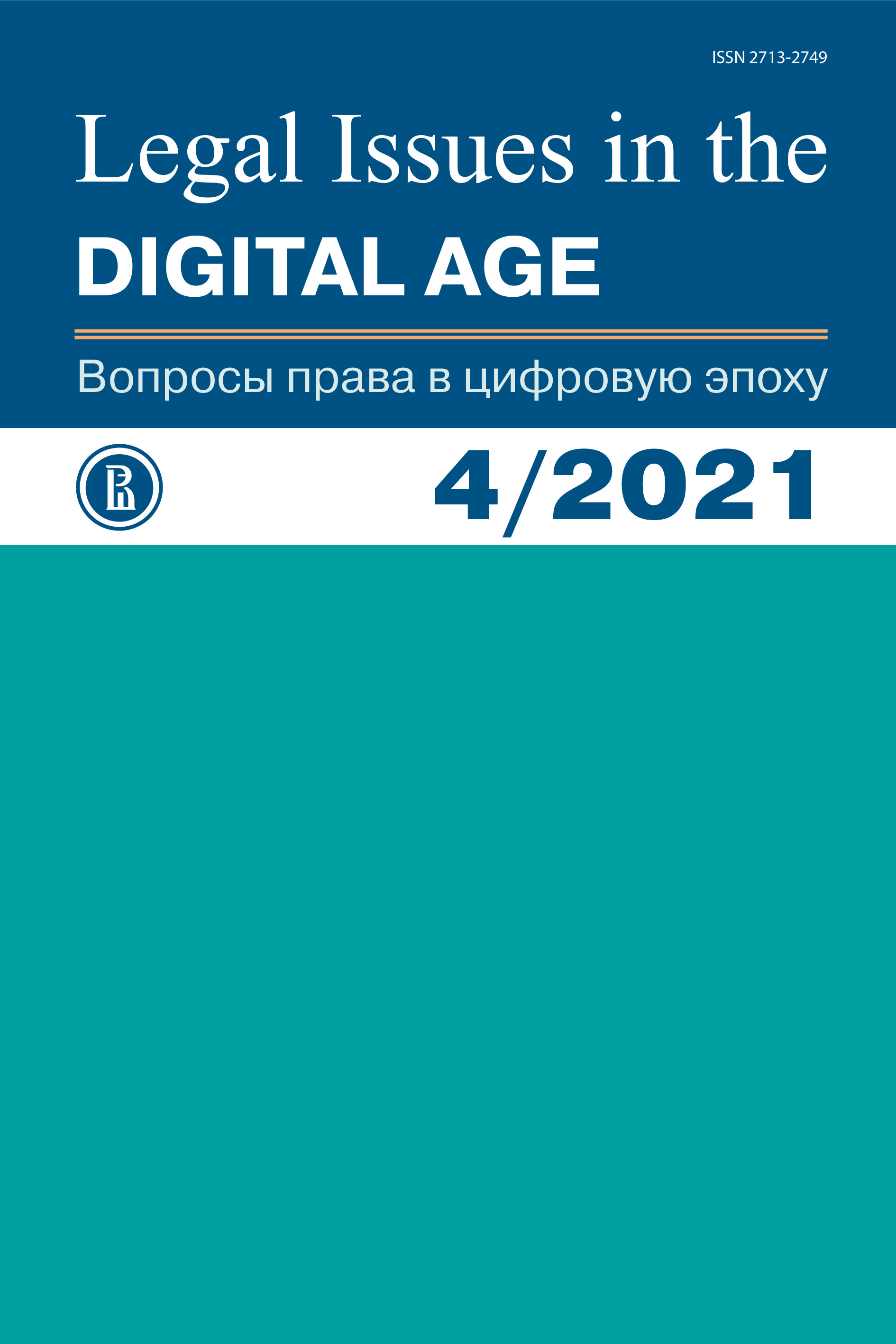Understanding the Algorithm: Meaning, Socio-Legal Context and Concerns
Abstract
At present, algorithms are becoming the heart of society by taking control over the decision-making process as societies are increasingly getting digitalised. There is a consistent theme that an unaccountable, black box technology has taken over the stage and is now making decisions for us, with us, and about us. But the contention around public participation in making decisions in science and technology needs to advance to a stage where there is a more direct conversation between the public and those developing the technologies. With the above mentioned conception of moderating emerging technologies’ development, primarily digital technology due to its overreaching effects on humans and what humans interpret it to be. Firstly, the research through a literature survey is aimed to understand the meaning and nuances of the word algorithm. Then the analysis based on case study is focused on the algorithmic questions, such as bias, privacy, design, transparency, and accountability. In a larger context, concerns over jobs, ways of social interactions, etc., had been discussed, since these concerns are the result of the application of algorithms. The analysis of academic literature pointed out the vital facet of multiple understanding of the word algorithm. Further, the research also emphasizes the meaning of philosophy and politics in technology and its non-neutral nature.
References
Abu-Lughod L. (1991) Writing Against Culture. In: R. Fox (ed.) Recapturing Anthropology: Working in the Present. Philadelphia: School of American Research Press. pp. 137–162. https://philpapers.org/rec/ABUWAC
Ananny M., Crawford K. (2018) Seeing without knowing: Limitations of the transparency ideal and its application to algorithmic account-ability. New Media and Society, no. 20(3), pp. 973–989. https://doi.org/10.1177/1461444816676645 DOI: https://doi.org/10.1177/1461444816676645
Anderson J., Rainie L. (2014) Digital Life in 2025. The Future of Internet. Pew Research Center (accessed: 25.11.2021)
Arooni J. (2017) Algorithmic Harms: Simultaneous Results and Proponents of Privacy Violations for Individual Users. Algorithmic Harms: Simultaneous Results and Proponents of Privacy Violations for Individual Users. (accessed: 25.11.2021)
Beard J. (2014) Autonomous Weapons and Human Responsibilities. Georgetown Journal of International Law, vol. 45, no 6, pp. 618–678.
Bertolini A. (2013) Robots as products: The case for a realistic analysis of robotic applications and liability rules. Law, Innovation and Technology, no.2, pp. 214–247. https://doi.org/10.5235/17579961.5.2.214 DOI: https://doi.org/10.5235/17579961.5.2.214
Bozdag E. (2013) Bias in algorithmic filtering and personalisation. Ethics and Information Technology, no. 3, pp. 209–227. https://doi.org/10.1007/s10676-013-9321-6 DOI: https://doi.org/10.1007/s10676-013-9321-6
Brauneis R., Goodman E. (2017) Algorithmic Transparency for the Smart City. SSRN Electronic Journal, no. 103, pp. 103–176. https://doi.org/10.2139/ssrn.3012499 DOI: https://doi.org/10.2139/ssrn.3012499
Burrell J. (2016) How the machine ‘thinks’: Understanding opacity in machine learning algorithms. Big Data & Society, no. 1, pp. 1–12, 205395171562251. https://doi.org/10.1177/2053951715622512 DOI: https://doi.org/10.1177/2053951715622512
Burris B. (1980) Book Review: Outline of a Theory of Practice. Critical Sociology, pp. 89–91. https://doi.org/10.1177/089692058000900410 DOI: https://doi.org/10.1177/089692058000900410
Campisi P. (2013) Security and privacy in biometrics: Towards a holistic approach. In: Security and Privacy in Biometrics. L.: Springer. pp. 1–23. https://doi.org/10.1007/978-1-4471-5230-9_1 DOI: https://doi.org/10.1007/978-1-4471-5230-9_1
Ceruzzi P.E. (1998) A history of modern computing. Boston: MIT Press, 438 p.
Christian B., Griffiths T. (2016) Algorithms to live by: the computer science of human decisions. N.Y.: Henry Holt, 368 p.
Conger S., Pratt J.H., Loch K.D. (2013) Personal information privacy and emerging technologies. Information Systems Journal, no. 23, pp. 401–417. https://doi.org/10.1111/j.1365-2575.2012.00402.x DOI: https://doi.org/10.1111/j.1365-2575.2012.00402.x
Danks D., London A. J. (2017) Algorithmic bias in autonomous systems. IJCAI International Joint Conference on Artificial Intelligence, pp. 4691–4697. https://doi.org/10.24963/ijcai.2017/654 DOI: https://doi.org/10.24963/ijcai.2017/654
DeCew J.W. (1986) The Scope of Privacy in Law and Ethics. Law and Philosophy, no. 5, pp. 145–173. DOI: https://doi.org/10.1007/BF00190759
Devendorf L., Goodman E. (2015) The Algorithm Multiple, The Algorithm Material: Reconstructing Creative Practice. Contours of Algorithmic Life Conference. http://www.confectious.net/may-15-the-algorithm-multiple-the-algorithm-material-reconstructing-creative-practice-uc-davis/
Diakopoulos N. (2015) Algorithmic Accountability: Journalistic inves-tigation of computational power structures. Digital Journalism, no. 3, pp. 398–415. https://doi.org/10.1080/21670811.2014.976411 DOI: https://doi.org/10.1080/21670811.2014.976411
Dourish P. (2016) Algorithms and their others: Algorithmic culture in context: Big Data & Society, no.11, pp. 1–16, https://doi.org/10.1177/2053951716665128 DOI: https://doi.org/10.1177/2053951716665128
Elish M. C. (2016) Moral Crumple Zones: Cautionary Tales in Human-Robot Interaction (WeRobot. SSRN Electronic Journal, no. 1, pp. 1–26. https://doi.org/10.2139/ssrn.2757236 DOI: https://doi.org/10.2139/ssrn.2757236
Eslami M. et al. (2019) User Attitudes towards Algorithmic Opac-ity and Transparency in Online Reviewing Platforms. Human Fac-tors in Computing Systems Proceedings, pp. 1–14. https://doi.org/10.1145/3290605.3300724 DOI: https://doi.org/10.1145/3290605.3300724
Floridi L. (2016) On Human Dignity as a Foundation for the Right to Privacy. Philosophy and Technology, no. 4, pp. 307–312. https://doi.org/10.1007/s13347-016-0220-8 DOI: https://doi.org/10.1007/s13347-016-0220-8
Freidman B., Kahn H. (2002) Human values, ethics, and design. In: The human-computer interaction handbook: fundamentals, evolving technologies and emerging applications. Wash.: University of Washing-ton, pp. 1177–1201.
Fried C. (1984) Philosophical dimensions of privacy: an anthology. Cambridge: University Press, 426 p.
Gillespie T. (2014) The Relevance of Algorithms. In: T. Gillespie et al. (eds.) Media Technologies: Essays on Communication, Materiality, and Society. Boston: MIT Press. pp. 167–194. https://doi.org/10.7551/MIT-PRESS/9780262525374.001.0001 DOI: https://doi.org/10.7551/mitpress/9780262525374.003.0009
Gillespie T. (2016) Algorithm. In: B. Peters (ed.) Digital Keywords: A Vocabulary of Information Society and Culture. Princeton: University Press, pp. 18–30. DOI: https://doi.org/10.2307/j.ctvct0023.6
Goffey A. (2008) Algorithms. In: M. Fuller (Ed.) Software Studies. A Lexicon. Boston:MIT Press, pp. 15–20. https://mitpress.mit.edu/books/software-studies DOI: https://doi.org/10.7551/mitpress/7725.003.0004
Goldberg I., Hill A., Shostack A. (2001). TRUST, ETHICS, AND PRIVACY. Boston University Law Review, no. 81, pp. 407–422.
Granka L.A. (2010) The politics of search: A decade retrospective. Information Society, no. 5, pp. 364–374. https://doi.org/10.1080/01972243.2010.511560 DOI: https://doi.org/10.1080/01972243.2010.511560
Haines N. (1955) Responsibility and Accountability. Philosophy, no. 30, pp. 141–163. DOI: https://doi.org/10.1017/S0031819100034562
Hayes D. et al. (2017) Geolocation Tracking and Privacy Issues Associated with the Uber Mobile Application. Conference on the Information Systems Applied Research, vol. 10, no. 45, pp. 1–11.
Hildebrandt M. (2014) The Dawn of a Critical Transparency Right for the Profiling Era. In: Digital Enlightenment Yearbook, IOS Press, pp. 41–57.
Jensen T. E., Winthereik B. R. (2005) Book Review: The Body Multiple: Ontology in Medical Practice. Acta Sociologica, no. 3, pp. 266–268. https://doi.org/10.1177/000169930504800309 DOI: https://doi.org/10.1177/000169930504800309
Karnow C. (1996) Liability for Distributed Artificial Intelligences. Berkeley Technology Law Journal, no. 11, 147 p. https://doi.org/10.15779/Z38ZD4W
Kearns M., Roth A. (2020) Ethical algorithm design should guide technology regulation. Available at: https://www.brookings.edu/re-search/ethical-algorithm-design-should-guide-technology-regulation DOI: https://doi.org/10.1145/3440959.3440966
Koene A. (2017) Algorithmic Bias: Addressing Growing Concerns. IEEE Technology and Society Magazine, no. 2, pp. 31–32. https://doi.org/10.1109/MTS.2017.2697080 DOI: https://doi.org/10.1109/MTS.2017.2697080
Kowalski R. (1979) Algorithm = logic + control. Communications of the ACM, no. 22(7), pp. 424–436. https://doi.org/10.1145/359131.359136 DOI: https://doi.org/10.1145/359131.359136
Kranzberg M. (1986) Technology and History: Kranzberg’s Laws; Technology and Culture, no. 3, p. 544. https://doi.org/10.2307/3105385 DOI: https://doi.org/10.2307/3105385
Lévy P. (2001) Cyberculture. Minneapolis: University of Minnesota Press. 280 p.
LoPucki, L. (2018) Algorithmic Entities. Washington University Law Review, no. 4, p. 887.
Lum K., Chowdhury R. (2021) What is an ‘algorithm’? It depends whom you ask. MIT Technology Review. Available at: https://www.tech-nologyreview.com/2021/02/26/1020007/what-is-an-algorithm/
Martin K. (2019) Designing ethical algorithms. MIS Quarterly Executive, no. 2, pp. 129–142. https://doi.org/10.17705/2msqe.00012 DOI: https://doi.org/10.17705/2msqe.00012
Mateas M., Montfort N. (2005) A Darkly: Obfuscation, Weird Languages, and Code Aesthetics.
Mol A. (2002) The body multiple: ontology in medical practice. Durham: Duke University Press. 216 p. DOI: https://doi.org/10.1215/9780822384151
Nayak S. (2013) Copyright Protection for Computer Software an Indian Prospective — Intellectual Property — India. Available at: https://www.mondaq.com/india/copyright/262564/copyright-protection-for-computer-software-an-indian-prospective
Nieborg D.B., Poell T. (2018) The platformization of cultural production: Theorising the contingent cultural commodity. New Media and Society, vol. 11, pp. 4275–4292. DOI: https://doi.org/10.1177/1461444818769694
NTSB. (2018) Collision Between a Sport Utility Vehicle Operating with Partial Driving Automation and a Crash Attenuator. Washington: NTSB, 74 p.
Panday, J. (2017) India’s Supreme Court Upholds Right to Privacy as a Fundamental Right and it’s about Time. Electronic Frontier Foundation. Available at: https://www.eff.org/deeplinks/2017/08/indias-supreme-court-upholds-right-privacy-fundamental-right-and-its-about-time
Parent W. A. (1983) A New Definition of Privacy for the Law. Law and Philosophy, no. 3, p. 305. https://doi.org/10.2307/3504563 DOI: https://doi.org/10.2307/3504563
Pasquale F. (2013) The Emperor’s New Codes. P. 1–86.
Phillips J. W. (2011) Secrecy and Transparency: An Interview with Samuel Weber. Theory, Culture & Society, no. 8, pp. 158–172. https://doi.org/10.1177/0263276411428339 DOI: https://doi.org/10.1177/0263276411428339
Puttaswamy v. India. Global Freedom of Expression (2017). Avail-able at: https://inforrm.org/2017/09/04/case-law-india-puttaswamy-v-union-of-india-supreme-court-recognises-a-constitutional-right-to-privacy-in-a-landmark-judgment-hug
Rubel A. et al. (2018) Algorithms, bias, and the importance of agency. CEUR Workshop Proceedings, pp. 9–13.
Rushe D. (2020) Tesla driver who died in ‘autopilot’ crash was playing on phone, inquiry finds. The Guardian. Available at: https://www.the-guardian.com/technology/2020/feb/25/tesla-driver-autopilot-crash
Seaver N. (2013) Knowing Algorithms. In: Digital STS Field Guide, pp. 412–422. https://doi.org/10.2307/j.ctvc77mp9.30 DOI: https://doi.org/10.2307/j.ctvc77mp9.30
Seaver N. (2017) Algorithms as culture: Some tactics for the ethnography of algorithmic systems. Big Data and Society, no. 2, pp. 1–12. https://doi.org/10.1177/2053951717738104 DOI: https://doi.org/10.1177/2053951717738104
Shabana N. (2015) An Indian Outline On Database Protection — Privacy — India. Available at: https://www.mondaq.com/india/data-protec-tion/450526/an-indian-outline-on-database-protection
Siddiqui F. (2019). Tesla sued by family of Apple engineer killed in Autopilot crash. Available at: https://www.washingtonpost.com/technol-ogy/2019/05/01/tesla-sued-by-family-man-killed-autopilot-crash/
Striphas T. (2015) Algorithmic culture. European Journal of Cultural Stud-ies, no. 4–5, pp. 395–412. https://doi.org/10.1177/1367549415577392 DOI: https://doi.org/10.1177/1367549415577392
Teixeira A. C. et al. (2017) Complexities of Cyberculture in Pierre Lévy and Developments in Education. Creative Education, no 1, pp. 119–130. https://doi.org/10.4236/CE.2017.81010 DOI: https://doi.org/10.4236/ce.2017.81010
Tene O. (2017) Taming the Golem: Challenges of Ethical Algorithmic Decision-Making. North Carolina Journal of Law & Technology, no. 19, 16 p.
Thomson J. J. (1975) The Right to Privacy. Philosophy & Public Affairs, no. 4, pp. 295–314.
Tjong Tjin Tai E. (2018a) Liability for (Semi)Autonomous Systems: Robots and Algorithms. SSRN Electronic Journal, pp. 55-82. https://doi.org/10.2139/ssrn.3161962 DOI: https://doi.org/10.2139/ssrn.3161962
Tufekci Z. (2015) Algorithmic Harms beyond Facebook and Google: Emergent Challenges of Computational Agency. Journal on Telecommunications & High Tech Law, no. 23, pp. 203–216. https://doi.org/10.1525/sp.2007.54.1.23. DOI: https://doi.org/10.1525/sp.2007.54.1.23
Tufekci Z., York J. C. et al. (2015) The Ethics of Algorithms: from radical content to self-driving cars. Available at: https://cihr.eu/publication-the-ethics-of-algorithms/
Verbeek P. P. (2008) Morality in Design, Design Ethics and the Morality. Design, pp. 91–103. DOI: https://doi.org/10.1007/978-1-4020-6591-0_7
Williams R. (1983). Keywords: A vocabulary of culture and society. Oxford: University Press.
Wirth N. (1975) Algorithms Plus Data Structures Equals Programs. Prentice Hall (Issue August). (Prentice-Hall series in automatic computation)
Authors who publish with this journal agree to the Licensing, Copyright, Open Access and Repository Policy.







